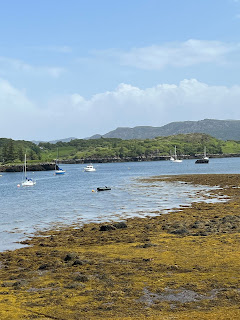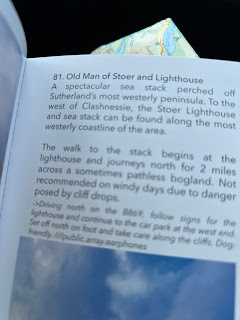Wester Ross did not disappoint with its steep roads, long lochs, traditional Applecross village & then the challenging Bealach na Ba pass. The weather turned cooler & the mountains had a dusting of snow on them. Some heavy rain set in too & we were glad of our flask of coffee & some biscuits while we stopped at the various lookouts ...
Leaving Ullapool & driving along the pretty Loch Broom with its windy road, you soon realise that these steep mountains & glens are not far away, with the towering peaks & falling waterfalls. It has its fair share of small fishing villages & stunning white sandy beaches.
I knew something of the Russian Artic Convoy units of WW11 who were tasked with keeping the northern passage open from Scotland to Russia. It was under very challenging conditions because it is in the artic circle & the ships were breaking winter ice, they were being bombarded by the Nazi's & it was a really tough time. These service people campaigned long & hard for their own war medal & this was eventually granted in 2015, about the same time as the Land Army women were granted their own medals too.
We stopped at the Artic Convoy museum & it was an interesting experience to learn more of this exemplary unit. Loch Ewe was an important Scottish port for the Artic convoys & the harbour / cove had special metal circles strung across the entrance to stop u-boats coming in to the harbour. We stopped along the road at several places where signboards showed more of this important time.
Loch Ewe still maintains its important naval link today
Loch Ewe today
Nowadays Loch Ewe still has a naval presence, there is a NATO fuel station near Aultbea where naval vessels can refuel and in Mellon Charles is a small Navy depot. Most buildings that were used in WW2 are still present today. The most impressive site is north of Cove, at Rubha nan Sasan. Here are a lot of buildings overlooking the Minch and Loch Ewe including a memorial with the following inscription: “In memory of our shipmates who sailed from Loch Ewe during World War II. They lost their lives in the bitter arctic sea battles to north Russia and never returned to this tranquil anchorage. We will always remember them.” Other remains of the wartime military presence can be found near Tournaig Farm, in Aultbea and at the end of the road at Mellon Charles. The NATO is still using Loch Ewe as an exercise area, usually in spring and autumn.
These peaceful, pretty harbour villages show that fishing on a modest scale is still done
Strome castle is another small, ruined 15th century castle that was once owned by Alexander Macdonald, Lord of the Isles & Earl of Ross. It changed hands between several clan families before it came to be in the present state:Shieldaig is a little harbour village with pretty white buildings, a peaceful setting. However, it is one of the many towns along this coastline with a strong military connection because of their proximity to the northern coast & sea routes. This remote village was developed in the 1800s to train seamen for the war against Napoleon. The forests around it provided trees for warships & the hidden cove was a perfect place for the training. It affords good views over to Loch Torridon & this rugged landscape has a charm of its own.
I have been to the Victoria Falls that is a between Zambia & Zimbabwe, it is a fall that is known to generations of my family so seeing mention of another Victoria Falls demanded a stop. The Guidebook Destination NC500 incorrectly places the original falls in South Africa ...
This Victoria Falls was visited by Queen Victoria in 1877 & is accessed by a flat walk to a viewing platform. It was pretty but not remarkable, definitely not the Smoke that Thunders of the Southern Africa one but it was an opportunity to stretch our legs & visit it.
The Applecross pass or Bealach na Ba was a rovers track in times gone by where cattle would be moved from the highlands down.
The historic mountain pass was built in 1822 and is engineered similarly to roads through the great mountain passes in the Alps, with very tight hairpin bends that switch back and forth up the hillside and gradients that approach 20%. It has the greatest ascent of any road climb in the United Kingdom, rising from sea level at Applecross to 626 m (2,054 ft) in about 6 km (3.7 mi), and is the third highest road in Scotland. (Wiki)
The roads leading to it are a taster of what is to come with twists & turns & stunning views of the mountains as the road changes direction. It reminded me of the mountain passes we travelled monthly from our remote community in Lesotho.
The pass is a steep single track with small passing places along the way, many of the passing places just enough for 1 vehicle to pull in. It is definitely not suitable for nervous drivers or large camper vans that are widely seen on this route. We had 2 motor bikes that passed us numerous times, they stopped or we stopped to do photos then we let them pass again so they could have the benefit of the spectacular views without being stuck behind a tall vehicle. There are many black tyre tracks along the steep parts as vehicles obviously had to brake hard while descending or waiting for oncoming vehicles.
We stopped for the night in Lochcarron, a little seaside town that was hospitable but not remarkable (though hubby was impressed with their golf course that you drive through)
The day's planning over breakfast decided that since we were so close to the Isle of Skye, it would be our trip for the day. The road was another beautiful loch side trip to the bridge connecting Skye to the mainland, but that deserves its own post.
Thank you for taking time to visit, like, comment or share, I really do appreciate it.
Dee 🌊🚤🚙🏴


















































